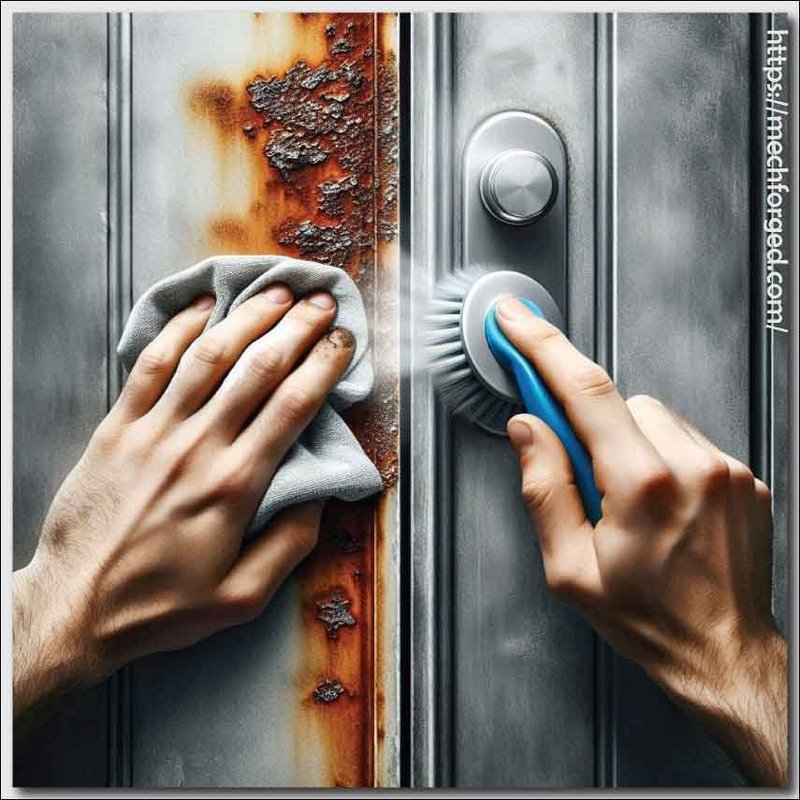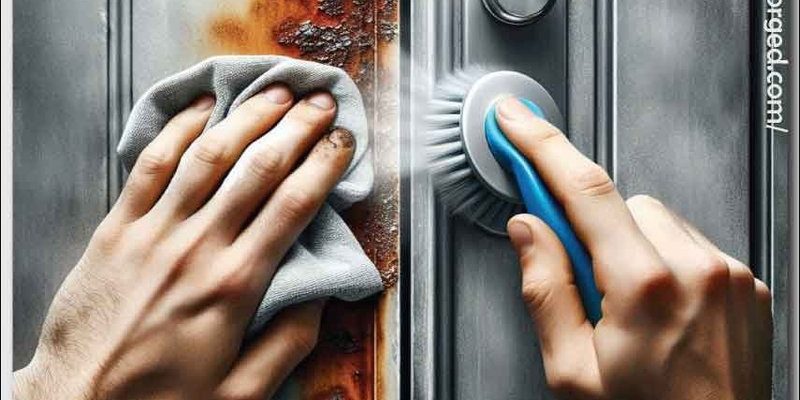
Here’s the deal: removing rust isn’t one-size-fits-all. The method you use on a matte black Emtek handle might totally wreck a polished brass Yale knob. And while there are plenty of online hacks—lemon juice here, baking soda there—they don’t all work the same on every hardware finish. Using the wrong stuff can strip the color, scratch the surface, or even break down a protective coating. That’s why knowing your hardware’s finish (and the brand, if you can) matters way more than you might think when picking your rust removal method.
So, whether you’re dealing with rust on a satin nickel Schlage lock, antique bronze Baldwin handle, or even a stainless steel Kwikset smart lock, let’s walk through how to handle each finish safely, step-by-step. I’ll show you what works, what doesn’t, and how to keep your door’s style sharp—not spotty.
Why Rust Forms On Exterior Door Hardware
You might be wondering, “Why does my door hardware even rust, especially if it’s labeled as ‘weather-resistant’ or ‘rust-proof’?” Here’s the thing: most exterior hardware is tough, but it’s not invincible. The iron or steel underneath many finishes reacts with oxygen and moisture in the air. When that happens, rust forms—even on brands like Schlage, Kwikset, and Yale that claim high durability.
It isn’t just rain that’s the problem. Even humidity, salty winds (hello, coastal living), and snow can sneak in and trigger rust. Sometimes, the finish gets scratched or chipped, letting water reach the vulnerable metal below. Other times, the finish itself is thin or fades with UV exposure, losing its protective power over time.
Rust doesn’t just look bad; if left alone, it can eat away at the hardware, making locks jam or levers feel loose. That’s why quick action is important—even more so with electronics, like smart lock remotes, where rust can mess with connections and battery contacts. No matter the finish, understanding the “why” behind rust gives you the upper hand when it comes to removing and preventing it in the future.
How To Identify Your Door Hardware Finish
Before you reach for that bottle of cleaner or start Googling “how to remove rust from my door handle,” pause for a second. What’s the finish on your hardware? Is it classic polished brass, brushed nickel, oil-rubbed bronze, matte black, or stainless steel? Brands like Baldwin, Emtek, and Kwikset all use different plating, lacquers, and chemicals—some are delicate, others are robust.
If you’re not sure, grab a flashlight and take a close look. Polished brass is super shiny and gold-toned; satin nickel has a soft, silvery-gray look, almost like it’s “brushed”; matte black is smooth but absorbs light instead of reflecting it. Oil-rubbed bronze looks dark brown with faint copper highlights on the edges. Stainless steel is silvery, with a subtle shine, and feels cool to the touch. Sometimes, brands stamp the finish type on the inside plate or packaging.
Why does this step matter? Because using a harsh scrub on a delicate finish (like aged bronze) could leave permanent scratches. And using a metal polish on powder-coated matte black can dull or strip the color completely. Getting the finish right up front protects your hardware while you treat the rust—think of it like knowing your skin type before trying a new skin routine.
Gentle Rust Removal For Polished Brass And Satin Nickel
Let me explain: polished brass and satin nickel are both popular for their elegant look, but they’re also pretty sensitive. Most of the time, these finishes are just a thin plating over another metal, sometimes even plastic. If you go at them with steel wool or a strong chemical, you’ll scratch or strip them before you blink.
Here’s the best method:
- Mix a mild paste of baking soda and water. Use just enough water to make a thick, spreadable paste.
- Apply the paste directly onto the rust spots. You can use a soft cloth, cotton swab, or even your finger for small areas.
- Let it sit for 30 minutes. Honestly, the longer you give it, the more time it has to break up the rust.
- Wipe gently with a damp microfiber cloth. Don’t scrub—just gentle, circular motions. If you see improvement, repeat if needed.
For finishes from Schlage, Kwikset, or Yale, this method is gentle enough not to disturb their protective lacquer. Never use vinegar or lemon juice on brass or nickel—they’re too acidic and will cause discoloration or dullness.
Personal tip: If the rust is super stubborn, dab a *tiny* bit of non-gel toothpaste (yes, really!) on a cloth and rub lightly. Rinse well and dry completely with a soft towel.
How To Remove Rust From Oil-Rubbed Bronze And Matte Black Finishes
Oil-rubbed bronze and matte black look gorgeous—but let’s be real, they’re tricky. Both of these finishes can be damaged in a blink if you pick the wrong cleaning method. Emtek and Baldwin, in particular, warn against strong chemicals or abrasive pads. Here’s a slow, safe way to handle rust on these finishes:
- Dust the hardware gently. Use a dry microfiber cloth to remove any loose debris or spiderwebs.
- Apply a little olive oil or mineral oil onto a cloth. Rub it gently over the rust spots. Oil works to loosen surface rust without disturbing the finish.
- Let the oil sit for 15-30 minutes. This’ll soften the rust without stripping the color.
- Buff with a clean, dry cloth. Use light, circular motions. Most of the time, the rust will transfer to the cloth. If not, repeat—but don’t rush it.
If the finish still looks dull after rust removal, you can buff it lightly with a finish-protecting wax (check the brand’s website for recommended products).
Never use steel wool, scouring pads, or harsh sprays. They’ll scratch matte black and lift off the bronze’s surface highlights, leaving it patchy or even exposing the raw metal beneath.
Rust Removal For Stainless Steel And Chrome Door Hardware
Here’s where things get a little easier. Stainless steel and chrome are tough, shiny, and way more forgiving than softer finishes, but they’re still not immune to rust—especially on outdoor smart locks from brands like Yale or Kwikset.
Try this method:
- Soak a soft cloth in white vinegar. Wring it out so it’s damp, not dripping.
- Lay the cloth over the rusted section and let it sit for an hour. The vinegar helps dissolve the iron oxide (rust) without damaging the metal underneath.
- Remove the cloth and scrub gently with a non-abrasive sponge. Don’t use a scouring pad—just a regular kitchen sponge works fine.
- Rinse with clean water and dry completely. If leftover rust remains, repeat the process or try a dab of baking soda paste.
For tough spots or battery compartment contacts on remote-controlled locks, use a cotton swab dipped in vinegar and wipe carefully. Make sure that everything is totally dry before reassembling or inserting batteries.
Pro tip: If you need a little more muscle, sprinkle baking soda on the rust after the vinegar soak. This combo fizzes and lifts off even stubborn rust, but won’t scratch your finish.
Special Care For Antique Or Painted Finishes
Antique, distressed, or custom-painted door hardware has its own set of rules. Honestly, if the hardware is original, vintage, or matches a historic home, you’ll want to be extra cautious—sometimes, the value is in the patina, not a mirror shine.
Here’s how to play it safe:
- Spot test everything you try on an out-of-sight corner.
- Start with just a dry, soft cloth. Sometimes, gentle buffing lifts surface rust without any products at all.
- If you need a cleaner, use a very diluted dish soap solution (a couple drops of soap in a cup of water). Dab gently—not scrub—then wipe with a clean, damp cloth.
- Avoid soaking, acidic products, or abrasives. These can lift paint, blur original details, or even flake off decorative patinas.
Some brands, like Baldwin or Emtek, treat their antique finishes differently every year—so if you’re not sure, check the brand’s website for exact care instructions. If the hardware is truly irreplaceable, consider consulting a local restoration specialist for peace of mind.
Personal experience: I once over-cleaned a painted Baldwin knob and ended up with a weird, shiny blotch right in the middle. Less is more with these finishes!
When To Use Commercial Rust Removers (And When Not To)
Commercial rust removers look tempting, but let’s pause for a second. They work—no question—but they’re strong stuff. They’re usually loaded with acids that can dissolve rust in minutes. But, and this is the important part, they can also strip finish, tarnish metal, or loosen adhesive holding decorative plates in place.
My advice? Only use them:
- On solid stainless steel or chrome hardware (and even then, spot-test first).
- When all gentle methods have failed, but you’re okay with the risk to the finish.
- According to the manufacturer’s instructions—never let them sit longer than directed.
Never use commercial removers on brass, bronze, nickel, or painted hardware—there’s a high chance they’ll cause permanent damage. If you do go this route, rinse the hardware thoroughly with water and dry it right away to prevent new rust from forming.
Honestly, unless you’re dealing with a rental-grade stainless lever that’s already past its prime, stick to home remedies first. You’ll save the finish and keep your hardware looking sharp.
How To Prevent Rust From Coming Back
Now that you’ve tackled the rust, let’s talk prevention. There’s no magic fix, but there are simple habits and quick checks that can keep your exterior door hardware looking great for years.
- Dry hardware after rain or when you water plants nearby. Even a quick wipe helps prevent standing water from starting new rust spots.
- Apply a clear protective wax or spray twice a year. Most brands sell finish-safe protectants—look on their websites for recommendations that sync with your hardware’s finish.
- Avoid hanging wet objects (like wreaths or towels) on exterior knobs or levers. They trap moisture, creating the perfect environment for rust.
- Check for chips, scratches, or peeling coating regularly. Small touch-ups with finish-safe paint or lacquer can seal out water and air.
For electronic locks or remotes (think Kwikset Halo, Yale Assure, or Schlage Encode), check that battery compartments stay dry. Battery leaks plus moisture equals corrosion—trouble that no polish can fix.
Honestly, a little prevention goes a long way here. It’s like flossing for your door hardware—quick, easy, and you’ll thank yourself later.
Final Thoughts: Keep Your Entryway Looking Sharp
No hardware is totally rust-proof, especially when it faces the wild mix of weather, air, and daily use just outside your door. But once you know the finish you’re dealing with, and you’ve got a safe, finish-friendly method, rust becomes more of a mini-project than a disaster.
Remember: brands like Schlage, Baldwin, Kwikset, Emtek, and Yale all use specialized coatings and finishes—some tougher than others. Taking a little extra time to match your rust removal method to your hardware’s finish keeps things looking as good as new, without any guesswork or regrets.
So, next time you spot a rusty patch or a faint orange streak on your door hardware, you’ll know just what to do—carefully, confidently, and without risking a bigger headache down the road. That way, your entry stays inviting, your locks stay smooth, and rust won’t steal the spotlight ever again.
